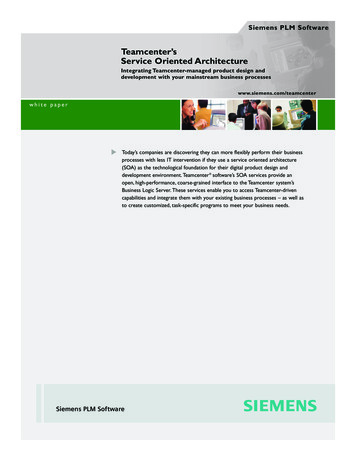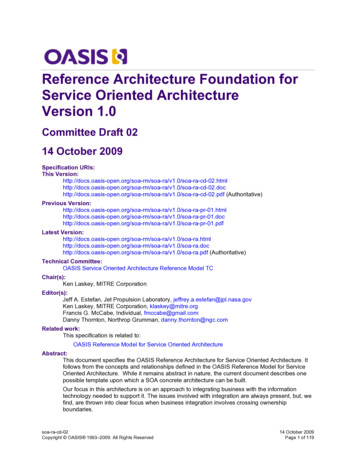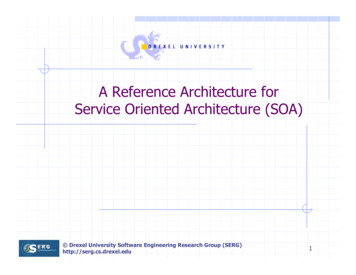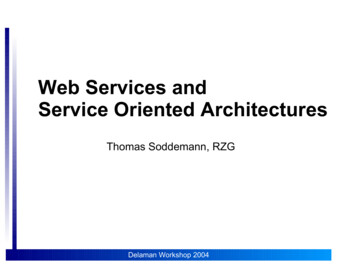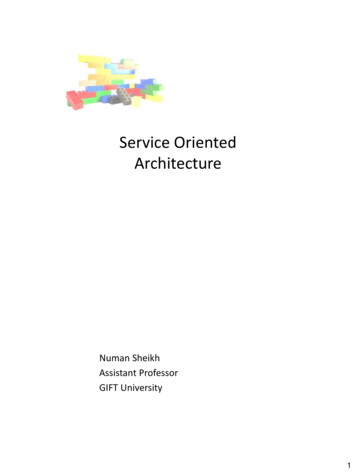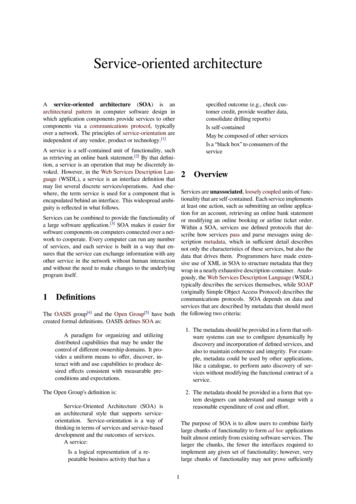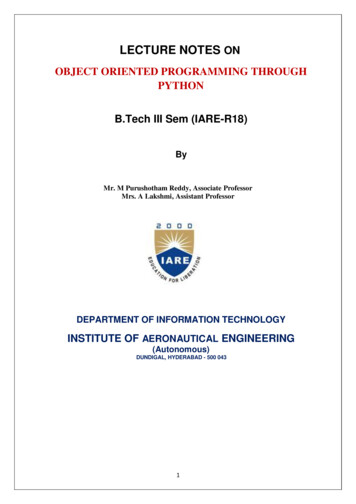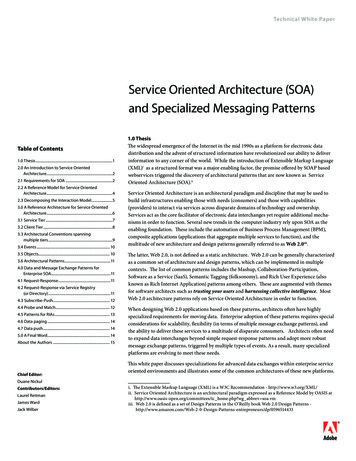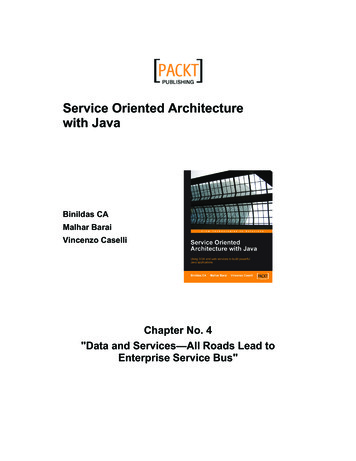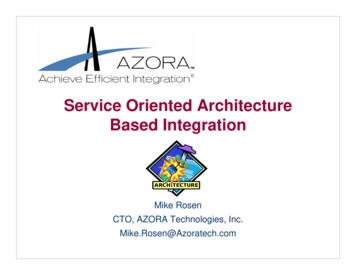
Transcription
Service Oriented ArchitectureBased IntegrationMike RosenCTO, AZORA Technologies, Inc.Mike.Rosen@Azoratech.com
Mike Rosen ACCESS TO THE EXPERTSConsultant Chief Enterprise Architect for service and component basedsystems– Finance, Insurance, Telecom SOA, EA, MDA implementation and training 20 years experience in distributed applications Author Cutter Consortium– “Service Oriented Integration – Aligning SOA with Enterprise Integration”– “Implementing SOA on Common Technologies” Implementing SOA Applications, due 2005 Developing e-Business Systems and Architecture: A Manager’s Guide, 2000, Morgan-KaufmanIntegrating CORBA and COM Applications, 1998, Wiley. Michael Rosen 2005Slide 2
Agenda Enterprise Application Integration Web Services to the Rescue What is Service Oriented Architecture? Business and Integration Services Enterprise Architecture for SOI Conclusion Michael Rosen 2005Slide 3
A Typical Integration ScenarioDataEAI DataIntegrationBank 1Account SystemBank 1Loan SystemDataEAIMethodIntegrationDataBank 2Account SystemDataBank 1Credit SystemBank 2Loan SystemDataDataBank 2Credit System Michael Rosen 2005Slide 4
Typical Enterprise Application IntegrationEnterprise Integration dapterIntegrationPointERPCRM Packaged Application Michael Rosen 2005Slide 5
Enterprise Application Integration Described by Process Automation/Workflow Adapters interface with applications at their integrationpoints Transformers change data and/or message format Enterprise Integration Server provides runtime Good concepts to apply to a bus model, rather than pointto-point Michael Rosen 2005Slide 6
The EAI Solution Doesn’t ScaleDataBank 1Account SystemBank 1Loan SystemDataDataBank 2Loan SystemDataBank 1Credit SystemBank 2Account SystemDataDataBank 2Credit System Michael Rosen 2005Slide 7
Enterprise Application “Spaghetti” Michael Rosen 2005Slide 8
EAI and Web Services Then Previous EAI products used proprietary protocols and techniques EAI applications were too expensive to implement. Many attempts at EAI failedMost EAI implementations created point-to-point connections,essentially new EAI stovepipesNow All EAI vendors are transitioning to Web Services to replace proprietary protocolsCOTS vendors are also supporting Web Services, thus drivingdown the cost of connectivity and integrationService Oriented Integration, using a new class of product call theEnterprise Service Bus, is now the target of EAI Michael Rosen 2005Slide 9
Web Services to the Rescue?ServiceServiceWeb ServiceWeb Service SOAP Service Bus Michael Rosen 2005Web ServiceWeb ServiceServiceApplicationServiceAdapter Slide 10
SOA History Service Oriented Architecture (SOA) is NOT new! Many Successful SOA Applications have beenbuilt in the past: CORBA (Wells Fargo, Credit Suisse) Tuxedo Many, many more attempts at SOA failed But, we can learn from what failed, and whatsucceeded Michael Rosen 2005Slide 11
SOA is Hard! Previous technical infrastructures were very difficult tomaster We did not adequately understand the characteristics ofservices and service design Requires an understanding of the business and informationand a strategic vision Requires an architectural based approach But architecture is hard too! Requires an appropriate methodology Requires a supporting organizational structure Michael Rosen 2005Slide 12
And Now, the Rest of the StoryBusinessBusinessModelModelEnterpriseBusiness ProcessdefineDefines tools, processesand technology for combiningservices into EBPServiceInfrastructureand FrameworksWeb ServiceSpecifies Definitionand requirementsof a serviceWeb ServiceDefines communications technologyfor application integration‘SOAP Service Bus’Defines commonsemantics and sTools Michael Rosen 2005Web ServiceCommonSemanticsand DataApplicationServiceAdapterSpecifies servicewrappingtechniquesSlide 13
What is an SOA? SOA is concerned with the independent construction ofservices which can be combined into meaningful, higherlevel business processes within the context of theenterprise. A Service Oriented Architecture describes several aspectsof services within an enterprise: The granularity and types of services How services are constructed How the services communicate at a technical level How the services are combined together (i.e. orchestrated) How the services interoperate at a semantic level (i.e. how they share common meanings)How services contribute to IT and Business Strategy Michael Rosen 2005Slide 14
Service Oriented Integration SOI An architectural and technology based approach toexposing and integrating existing applications as services Builds on EAI technology, using new Web services basedplatforms Exposes services to a bus, not point-to-point Extends SOA to integration solutions Michael Rosen 2005Slide 15
SOI: A Better ESB Business Service icesESB Integration Service BusBank 1Account System Michael Rosen 2005Bank 1Loan SystemBank 1Bank 2Bank 2Credit System Account System Loan SystemBank 2Credit SystemSlide 16
Benefits of SOA Integration Approach Integrate once, connect many Each system is integrated once into the service bus, rather than many time for each point-to-point connectionLess cost, consistent accessBuild up higher level business services Combine lower level operations into business services that align with the goals and strategy of the new enterprise, rather than of the old systemsQuickly construct high-level, high-value business processes from thebusiness services in response to new initiatives, competitive pressures,regulatory changes, Flexibility Multiple services can be easily constructed from the integration of existing applicationsNew processes can be constructed from the service Michael Rosen 2005Slide 17
Benefits of SOI Approach (2) Adaptability to change Business Processes change quickly Operational Systems are difficult, costly and slow to change– Layered SOI approach enables quickly reconfiguring processes or serviceswithout needing to change operational systems Operational systems are retired or replaced– Layered SOI approach allows operational systems to change without affectingbusiness processes Incremental Approach Start small Add new integration services, business services and processes over time, as part of specific projects, in response to specificbusiness needsFlexibility and capabilities increase exponentially with each newservice. Michael Rosen 2005Slide 18
Hierarchy of Service viceImplementedbyInternalBusiness ProcessusesBusinessComponent Michael Rosen 2005uses.IntegrationServiceSlide 19
Factors Affecting Services Granularity – Amount of work performed per invocation Fine Medium Large Visibility – Who can see and invoke the service Published Public Private Scope – Organization unit or boundary for the service Application Workgroup Line-of-business or division Enterprise Michael Rosen 2005Slide 20
Integration Services An architectural and implementation approach tointegration using Web services and SOA Data Integration Service – provides data integrationbetween multiple applications. Initiated by a legacy systemin which data has changed. Frequently implemented asPublish and Subscribe. Functional Integration Service – provides sharedfunctionality between multiple applications. Initiated by theapplication requiring the functionality. Not the same as SOA Business Services!!! Although often treated the same. Michael Rosen 2005Slide 21
Integration Services (2) Integration services provide interface to existing application Interface granularity influenced by existing applications Synchronous Invocation is common ACID Transactions may be required Not exposed directly to business services Wrapped by business components or other services Hide internal API’s, data models and application topology Enhance, modify or combine existing functionality Michael Rosen 2005Slide 22
Integration Service PatternService InvocationService cy ApplicationsLegacyAdapterComponentService Implementation Michael Rosen 2005Slide 23
Common ‘Bottom Up’ Approach Start with existing application functionality Expose functionality as a ‘service’ using existing API Expose data model in the service interface Creates dependency between existing application and new service interfaceAPI and data model dependencies create functionally and semanticallyincompatible service interactions, essentially limiting service to point-topoint integrationNot driven by enterprise requirementsPromoted by tool vendors Service interface can be generated Makes a great demo EAI all over again New Web services technologies Same old architectural problems Michael Rosen 2005Slide 24
Layered Enterprise SOI SWSISISISISComponentsand IntegrationServicesEnterpriseResources Michael Rosen 2005Slide 25
SOI Enterprise Architecture Layers Layer 1 – Enterprise Resources and Operational Systems Consist of existing applications, legacy and COTS systems, CRM and ERP applications, and older OO implementationsProvide ‘business operations’ – transactions implementing singleunits of work within the operational systemsTypically access or modify data in a ‘System of Record’Layer 2 – Components and Integration Services Integration Services provide access to the resources and systems of Layer 1Components wrap integration servicesComponents provide a ‘single point of contact’ for integrationservices, preventing a proliferation of cut-and-paste codeComponents are typically implemented with EJB or .NETIntegration services are increasingly being implemented with Webservices Michael Rosen 2005Slide 26
SOI Architecture Layers (2) Layer 3 – Business Services Provide high level business functionality throughout the enterprise Provide a ‘service interface’ layer of abstraction to the functionality of layer 2Services are managed, governed enterprise assets with SLAsRepresent a logical grouping of component, integration servicesand operationsLayer 4 – Business Processes Processes are a series of activities which are executed in an ordered sequence according to a set of business rules (called achoreography or business process model)Executed in response to business eventsProvide long-running sets of activitiesComposed of multiple services and typically involving multipleservice invocations Michael Rosen 2005Slide 27
Enterprise Information Design Equally important to enterprise flexibility and agility Defines the business semantics needed to support theenterprise processes and services Critical to ‘ad-hoc’ combination of services into businessprocesses Coordinated with enterprise process design Michael Rosen 2005Slide 28
Enterprise Information LayersProcess Data ModelSemanticDataModel Michael Rosen irtual Object DataXformSORPhysical ModelOperationalDataSlide 29
Enterprise Information Layers (2) Operational Data Resides in systems of record and other operational data stores Described by the ‘Physical Data Model’ Integration Data Operational data is exchanged between operational systems Data is extracted from one system, transformed, and the loaded to another Semantic (Consolidated) Data Provides the data required by the service interfaces Described by the ‘Virtual Data Model’ Implemented by a mapping/transformation of the operational data Enterprise Data Business Documents provide a composite of semantic business objects tosupport enterprise processes Michael Rosen 2005Slide 30
Scope of SOA ConstructsEnterpriseScopeScopeLine of cationScope Michael Rosen 2005OrganizationalindependenceSlide 31
Putting it all nentsand OR Michael Rosen 2005Line of BusinessScopeWorkgroupScopeApplicationScopeSlide 32
The Enterprise Service Bus Provides an ideal platform for SOI Applications Integration Infrastructure – exposing existingapplications as services Service Infrastructure – defining, implementing,invoking and combining services Enterprise Strength – enterprise classmanagement, scalability, performance, reliability Full Disclosure Notice: The author does not represent or promote any specificESB products (although he has used several and has his own opinions (incidentally notshared by the International House of Architecture).He does not own stock or stand to profit in anyway should you decide to follow hisrecommendations (actually, I still have a pile of BEA, but that’s another story ) Michael Rosen 2005Slide 33
Requirements of Different Service TypesRequirementIntegration ServiceBusiness ServiceDesignExpose existing applicationfunctionality and dataProvide services aligned withEnterprise Business ModelSemanticsand DataBased on operational datamodels, required significanttransformation servicesBased on enterprise semanticmodel. Some aggregation,minimal transformationInvoke by a business processInvocationEvent driven, orinvoked by other services:Synchronous request/reply,events, fire-and-forgetDevelopmentRequires specialized adapters for New development using ESBconnection to legacy systemsAPIs directlyImportantFeaturesSynchronous request/reply,events, publish and subscribe Integration Message Processing QoS Security and Management Michael Rosen 2005Asynchronous request/replyor fire-and-forget Asynchronous request/replyService Interaction Process Orchestration SLA Security and Management Slide 34
We’re all Bozos on this BusBusinessProcessBusinessProcessBusiness Service ESBBusinessServiceBusinessServiceIntegration Service ESB Michael Rosen ide 35
Summary SOI combines Web service, EAI and SOA Driven top down by business requirements and model Driven bottom up by existing applications SOI provides an level of indirection between operationalsystem’s API and data and Enterprise defined semantics,services and processes This leads to a more flexible, agile enterprise Integration Services are fundamentally different thanBusiness Services Michael Rosen 2005Slide 36
Integration Service Summary Provides service access to existing systems Responsible for mapping between Enterprise business /service model and existing application functionality Responsible for mapping between Enterprise Semanticmodel and existing application data model Simultaneously insulates and integrates Michael Rosen 2005Slide 37
Implementing SOI Integration Requires Architecture Describe the essential context to enable cooperating services But phase in the details as needed Business Model Describe processes, services, interfaces, enterprise data andsemantics Tools Support service construction Incorporate architectural concepts Implement Service composition Provide platform independence of business logic Michael Rosen 2005Slide 38
Questions
– “Service Oriented Integration – Aligning SOA with Enterprise Integration” – “Implementing SOA on Common Technologies” Implementing SOA Applications, due 2005 Developing e-Business Systems and Architecture: A Manager’s Guide, 2000, Morgan-Kaufman Integrating CORBA

